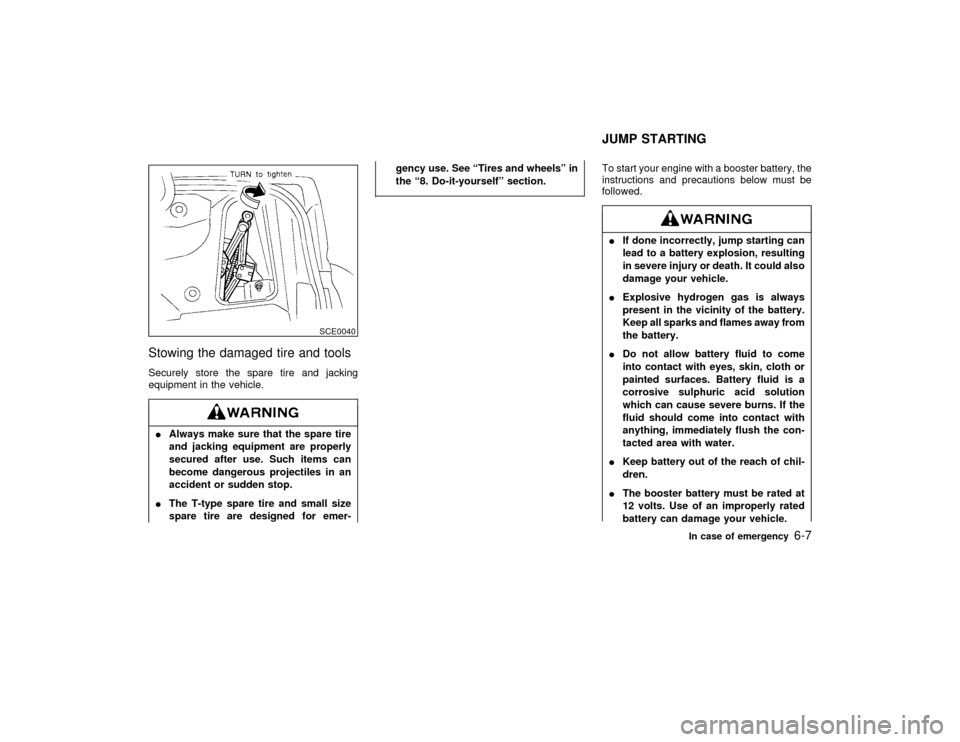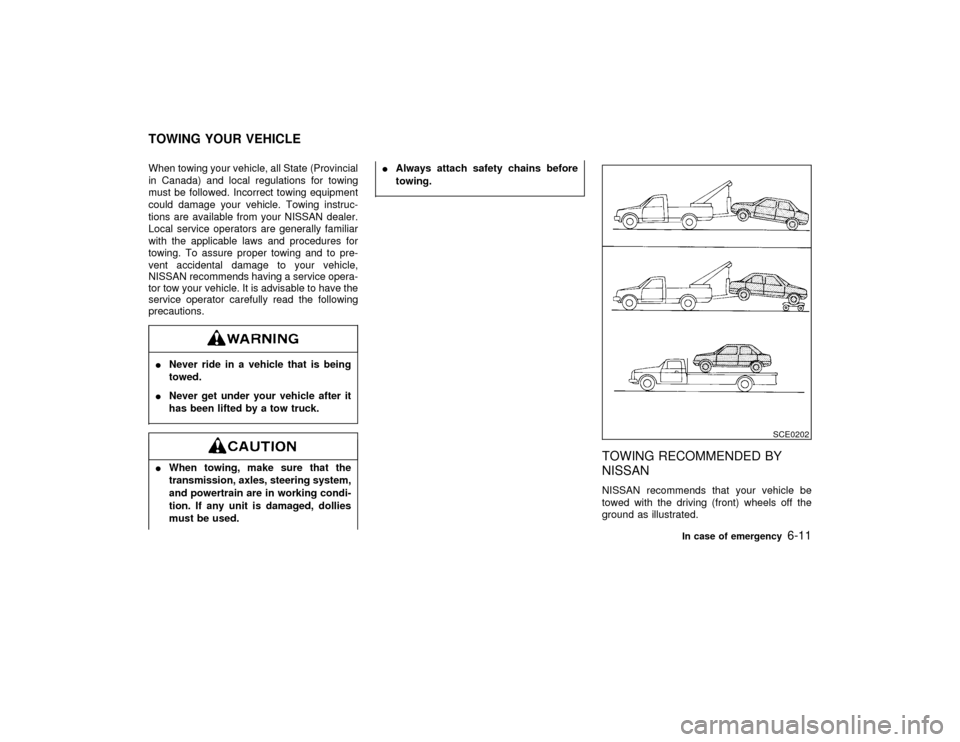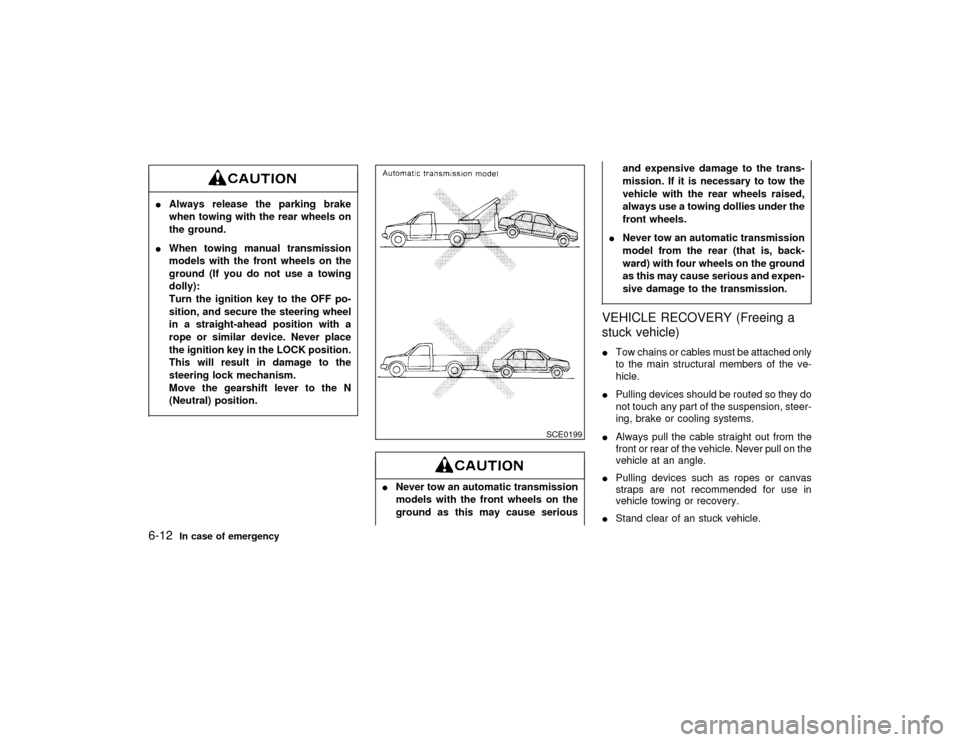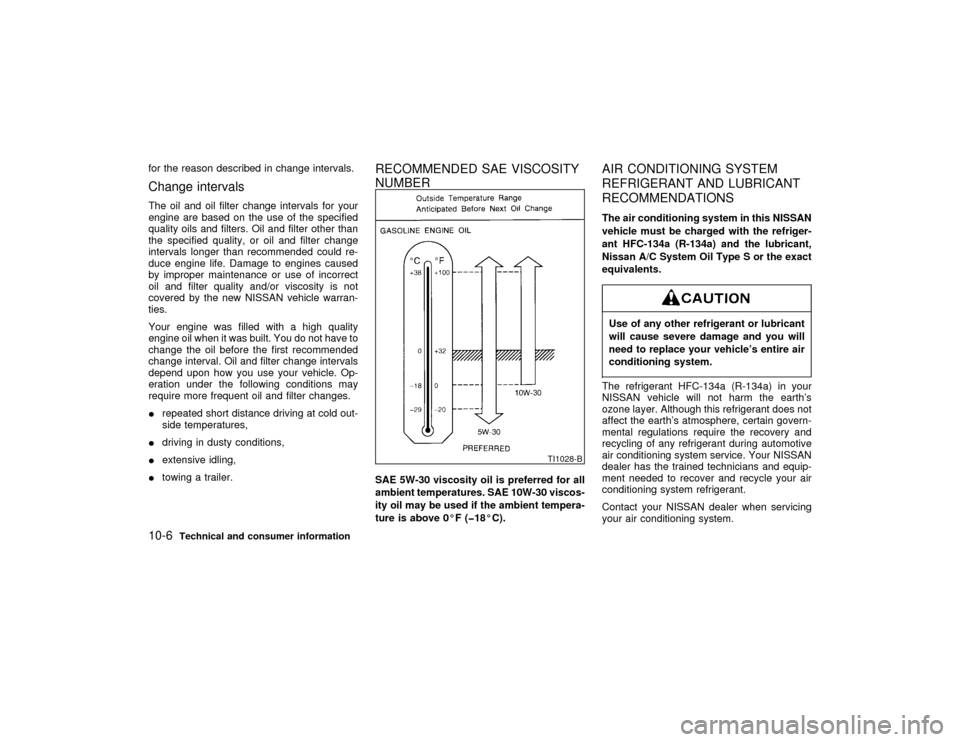1999 NISSAN MAXIMA towing
[x] Cancel search: towingPage 140 of 233

6 In case of emergencyFlat tire ...................................................................... 6-2
Changing a flat tire .................................................... 6-2
Jump starting............................................................. 6-7
Push starting ............................................................. 6-9If your vehicle overheats ......................................... 6-10
Towing your vehicle ................................................ 6-11
Towing recommended by NISSAN ......................... 6-11
Vehicle recovery (Freeing a stuck vehicle) ............. 6-12
Z
01.1.22/A32-D/V5.0
X
Page 146 of 233

Stowing the damaged tire and toolsSecurely store the spare tire and jacking
equipment in the vehicle.IAlways make sure that the spare tire
and jacking equipment are properly
secured after use. Such items can
become dangerous projectiles in an
accident or sudden stop.
IThe T-type spare tire and small size
spare tire are designed for emer-gency use. See ªTires and wheelsº in
the ª8. Do-it-yourselfº section.
To start your engine with a booster battery, the
instructions and precautions below must be
followed.IIf done incorrectly, jump starting can
lead to a battery explosion, resulting
in severe injury or death. It could also
damage your vehicle.
IExplosive hydrogen gas is always
present in the vicinity of the battery.
Keep all sparks and flames away from
the battery.
IDo not allow battery fluid to come
into contact with eyes, skin, cloth or
painted surfaces. Battery fluid is a
corrosive sulphuric acid solution
which can cause severe burns. If the
fluid should come into contact with
anything, immediately flush the con-
tacted area with water.
IKeep battery out of the reach of chil-
dren.
IThe booster battery must be rated at
12 volts. Use of an improperly rated
battery can damage your vehicle.
SCE0040
JUMP STARTING
In case of emergency
6-7
Z
01.1.22/A32-D/V5.0
X
Page 150 of 233

When towing your vehicle, all State (Provincial
in Canada) and local regulations for towing
must be followed. Incorrect towing equipment
could damage your vehicle. Towing instruc-
tions are available from your NISSAN dealer.
Local service operators are generally familiar
with the applicable laws and procedures for
towing. To assure proper towing and to pre-
vent accidental damage to your vehicle,
NISSAN recommends having a service opera-
tor tow your vehicle. It is advisable to have the
service operator carefully read the following
precautions.INever ride in a vehicle that is being
towed.
INever get under your vehicle after it
has been lifted by a tow truck.IWhen towing, make sure that the
transmission, axles, steering system,
and powertrain are in working condi-
tion. If any unit is damaged, dollies
must be used.IAlways attach safety chains before
towing.
TOWING RECOMMENDED BY
NISSANNISSAN recommends that your vehicle be
towed with the driving (front) wheels off the
ground as illustrated.
SCE0202
TOWING YOUR VEHICLE
In case of emergency
6-11
Z
01.1.22/A32-D/V5.0
X
Page 151 of 233

IAlways release the parking brake
when towing with the rear wheels on
the ground.
IWhen towing manual transmission
models with the front wheels on the
ground (If you do not use a towing
dolly):
Turn the ignition key to the OFF po-
sition, and secure the steering wheel
in a straight-ahead position with a
rope or similar device. Never place
the ignition key in the LOCK position.
This will result in damage to the
steering lock mechanism.
Move the gearshift lever to the N
(Neutral) position.
INever tow an automatic transmission
models with the front wheels on the
ground as this may cause seriousand expensive damage to the trans-
mission. If it is necessary to tow the
vehicle with the rear wheels raised,
always use a towing dollies under the
front wheels.
INever tow an automatic transmission
model from the rear (that is, back-
ward) with four wheels on the ground
as this may cause serious and expen-
sive damage to the transmission.
VEHICLE RECOVERY (Freeing a
stuck vehicle)ITow chains or cables must be attached only
to the main structural members of the ve-
hicle.
IPulling devices should be routed so they do
not touch any part of the suspension, steer-
ing, brake or cooling systems.
IAlways pull the cable straight out from the
front or rear of the vehicle. Never pull on the
vehicle at an angle.
IPulling devices such as ropes or canvas
straps are not recommended for use in
vehicle towing or recovery.
IStand clear of an stuck vehicle.
SCE0199
6-12
In case of emergency
Z
01.1.22/A32-D/V5.0
X
Page 200 of 233

posed to corrosive substances such as those
used on icy roads or to control dust. It is very
important to remove these substances, other-
wise rust will form on the floor pan, frame, fuel
lines and around the exhaust system. At the
end of winter, the underbody should be thor-
oughly flushed with plain water, being careful
to clean those areas where mud and dirt may
accumulate. For additional information, see
ªCleaning exteriorº in the ª7. Appearance and
careº section.
Fluid leaks:Check under the vehicle for fuel,
oil, water or other fluid leaks after the vehicle
has been parked for a while. Water dripping
from the air conditioner after use is normal. If
you should notice any leaks or if gasoline
fumes are evident, check for the cause and
have it corrected immediately.To ensure smooth, trouble-free, safe and eco-
nomical driving, NISSAN provides two differ-
ent maintenance schedules that may be used,
depending upon the conditions in which you
usually drive. These schedules contain both
distance and time intervals, up to 60,000 miles
(96,000 km)/48 months. For most people, the
odometer reading will indicate when service is
needed. However, if you drive very little, your
vehicle should be serviced at the regular time
intervals shown in the schedule.After 60,000
miles (96,000 km) or 48 months, continue
the periodic maintenance at the same
mileage/time intervals.
SCHEDULE 1Follow Periodic Maintenance Schedule 1 if
your driving habits frequently include one or
more of the following driving conditions:
Irepeated short trips of less than 5 miles
(8 km).
Irepeated short trips of less than 10 miles
(16 km) with outside temperatures re-
maining below freezing.
Ioperating in hot weather in stop-and-go
rush hour traffic.
Iextensive idling and/or low speed driv-
ing for long distances, such as police,taxi or door-to-door delivery use.
Idriving in dusty conditions.
Idriving on rough, muddy, or salt spread
roads.
Itowing a trailer, using a camper or a
car-top carrier.
SCHEDULE 2Follow Periodic Maintenance Schedule 2 if
none of the driving conditions shown in Sched-
ule 1 apply to your driving habits.
PERIODIC MAINTENANCE
SCHEDULES
Maintenance
9-5
Z
01.1.22/A32-D/V5.0
X
Page 202 of 233

Schedule 1Abbreviations: I = Inspect. Correct or replace if necessary.MAINTENANCE OPERATIONMAINTENANCE INTERVAL
Perform at number of miles, kilometers or
months, whichever comes first.Miles x 1,000 3.75 7.5 11.25 15 18.75 22.5 26.25 30 33.75 37.5 41.25 45 48.75 52.5 56.25 60
(km x 1,000) (6) (12) (18) (24) (30) (36) (42) (48) (54) (60) (66) (72) (78) (84) (90) (96)
Months 3 6 9 12 15 18 21 24 27 30 33 36 39 42 45 48Chassis and body maintenanceBrake lines & cablesIIII
Brake pads & discsIIIIIIII
Manual transmission oil & automatic
transmission fluidSee NOTE (1).IIII
Steering gear & linkage, axle & suspension partsIIIIIIII
Exhaust systemIIIIIIII
Front drive shaft bootsIIIIIIII
Supplemental air bag system See NOTE (2).NOTE: (1) If towing a trailer, using a camper or a car-top carrier, or driving on rough or muddy roads, change (not just inspect) oil at
every 30,000 miles (48,000 km) or 24 months.
(2) Inspect the supplemental air bag system 10 years after the date of manufacture noted on the F.M.V.S.S. certification label.
Maintenance
9-7
Z
01.1.22/A32-D/V5.0
X
Page 206 of 233

10 Technical and consumer informationCapacities and recommended fuel/lubricants ......... 10-2
Fuel recommendation ............................................. 10-3
Engine oil and oil filter recommendation................. 10-5
Recommended SAE viscosity number.................... 10-6
Air conditioning system refrigerant and lubricant
recommendations .................................................... 10-6
Specifications .......................................................... 10-7
Engine ..................................................................... 10-7
Tires and wheels ..................................................... 10-8
Dimensions and weights ......................................... 10-8
When traveling or registering your vehicle in
another country ....................................................... 10-9
Vehicle identification ............................................... 10-9
Vehicle identification number (VIN) plate................ 10-9
Vehicle identification number
(Chassis number) .................................................... 10-9
Engine serial number ............................................ 10-10F.M.V.S.S. certification label ................................. 10-10
Emission control information label ........................ 10-10
Tire placard ........................................................... 10-11
Air conditioner specification label.......................... 10-11
Installing front license plate................................... 10-11
Vehicle loading information ................................... 10-12
Terms .................................................................... 10-12
Determining vehicle load capacity ........................ 10-12
Loading tips ........................................................... 10-13
Towing a trailer ..................................................... 10-13
Maximum load limits.............................................. 10-14
Towing safety ........................................................ 10-14
Uniform tire quality grading ................................... 10-17
Emission control system warranty ........................ 10-18
Reporting safety defects (US only) ....................... 10-18
Readiness for inspection/maintenance (I/M) test
(US only) ............................................................... 10-18
Z
01.1.22/A32-D/V5.0
X
Page 211 of 233

for the reason described in change intervals.Change intervalsThe oil and oil filter change intervals for your
engine are based on the use of the specified
quality oils and filters. Oil and filter other than
the specified quality, or oil and filter change
intervals longer than recommended could re-
duce engine life. Damage to engines caused
by improper maintenance or use of incorrect
oil and filter quality and/or viscosity is not
covered by the new NISSAN vehicle warran-
ties.
Your engine was filled with a high quality
engine oil when it was built. You do not have to
change the oil before the first recommended
change interval. Oil and filter change intervals
depend upon how you use your vehicle. Op-
eration under the following conditions may
require more frequent oil and filter changes.
Irepeated short distance driving at cold out-
side temperatures,
Idriving in dusty conditions,
Iextensive idling,
Itowing a trailer.
RECOMMENDED SAE VISCOSITY
NUMBERSAE 5W-30 viscosity oil is preferred for all
ambient temperatures. SAE 10W-30 viscos-
ity oil may be used if the ambient tempera-
ture is above 0ÉF (þ18ÉC).
AIR CONDITIONING SYSTEM
REFRIGERANT AND LUBRICANT
RECOMMENDATIONSThe air conditioning system in this NISSAN
vehicle must be charged with the refriger-
ant HFC-134a (R-134a) and the lubricant,
Nissan A/C System Oil Type S or the exact
equivalents.Use of any other refrigerant or lubricant
will cause severe damage and you will
need to replace your vehicle's entire air
conditioning system.The refrigerant HFC-134a (R-134a) in your
NISSAN vehicle will not harm the earth's
ozone layer. Although this refrigerant does not
affect the earth's atmosphere, certain govern-
mental regulations require the recovery and
recycling of any refrigerant during automotive
air conditioning system service. Your NISSAN
dealer has the trained technicians and equip-
ment needed to recover and recycle your air
conditioning system refrigerant.
Contact your NISSAN dealer when servicing
your air conditioning system.
TI1028-B
10-6
Technical and consumer information
Z
01.1.22/A32-D/V5.0
X